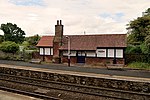Leighton Moss RSPB reserve

RSPB Leighton Moss is a nature reserve in Lancashire, England, which has been in the care of the Royal Society for the Protection of Birds since 1964. It is situated near Silverdale, Carnforth, on the edge of Morecambe Bay and in the Arnside and Silverdale Area of Outstanding Natural Beauty. Leighton Moss contains the largest area of reed bed in north-west England. The site provides habitats for many species of wildlife, including bearded tits, marsh harriers, bitterns, otters and red deer. As a wetland of international importance, it was designated a Ramsar site in 1985. It is a Site of Special Scientific Interest, a Special Protection Area, and an Important Bird Area.The RSPB also protects a large area of Morecambe Bay, where a saltmarsh provides a habitat for birds such as avocets.
Excerpt from the Wikipedia article Leighton Moss RSPB reserve (License: CC BY-SA 3.0, Authors, Images).Leighton Moss RSPB reserve
Quai des Tuileries, Paris Paris 1er Arrondissement (Paris)
Geographical coordinates (GPS) Address Phone number Website Nearby Places Show on map
Geographical coordinates (GPS)
| Latitude | Longitude |
|---|---|
| N 54.163 ° | E -2.801 ° |
Address
Musée de l'Orangerie
Quai des Tuileries
75001 Paris, Paris 1er Arrondissement (Paris)
Île-de-France, France
Open on Google Maps











